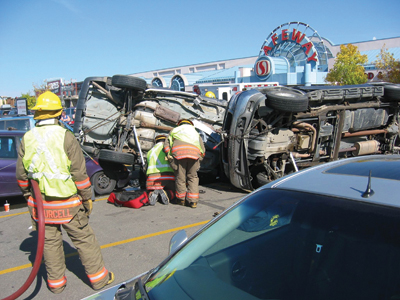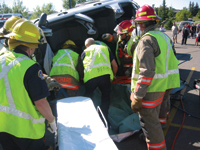
New vehicle technology
Randy Schmitz
Features Extrication TrainingNew vehicle technology, or NVT, seems to be the buzz-word in extrication these days. Today’s vehicles are safer, smaller and more fuel-efficient. The legislated improvements to Federal Motor Vehicle Safety Standard (FMVSS) 214 and, most recently, 216, deal with side and roof strength and also the integrity of motor vehicles.
New vehicle technology, or NVT, seems to be the buzz-word in extrication these days. Today’s vehicles are safer, smaller and more fuel-efficient. The legislated improvements to Federal Motor Vehicle Safety Standard (FMVSS) 214 and, most recently, 216, deal with side and roof strength and also the integrity of motor vehicles. The National Highway Traffic Safety Administration (NHTSA) is the governing body that imposes these standards, which are backed by the U.S. Department of Transportation. These standards state that vehicle manufacturers must meet a minimum requirement to limit crush intrusion into the passenger compartment, thus reducing injuries to vehicle occupants. Manufacturers are using ultra high strength steel, or multiple layers of steel, to repel crush forces from crash impact and absorb and inhibit these forces. FMVSS 216 doubles the roof strength requirement for light vehicles weighing up to 6,000 pounds. It specifies that the driver and passenger sides of the roof must withstand a force equal to three times the weight of the vehicle. The tougher roof crush requirements are part of a comprehensive plan to address rollover crashes, which kill about 10,000 people annually in Canada and the U.S, Quite a number of high-end luxury vehicles have met this standard previously but this will soon become mandatory even for entry-level vehicles. The phase-in schedule, which begins in September 2012, will be completed for all affected vehicles by the 2017 model year.

|
| Firefighters in Red Deer, Alta., were challenged by a multi-vehicle accident in a shopping centre parking lot after a Ford Escape flew over a van and landed on top of two unoccupied vehicles. The Ford driver had to be extricated. The incident happened at 2 p.m. on a Saturday. Spectators thought the department was staging an extrication exercise. Photo by Randy Schmitz |
This is great news for consumers but poses a challenge for rescuers who extricate patients from these vehicles, especially when crash forces at higher speeds are even beyond the limits of these exotic metals.
Although we are seeing people walk away from crashes that would have been fatal in the past, use of these new, high-strength materials lead some drivers to believe that the safer their cars are the faster they can drive and still be protected. Unfortunately this mindset is what keeps rescuers in business.
Not only is the steel in new vehicles changing, the size and shape of A-B- and C- pillars of the roof section are becoming much larger. This has an impact on rescuers’ hydraulic cutting capabilities, as a larger post may not allow the material to be drawn in close to the centre of the cutter’s blade, where the most severing force is generated.
The good news is that most hydraulic tool manufacturers are working to improve performance of their cutters to meet the ever-changing enhanced materials in new vehicles, and a few redesigned cutters have recently been released. Holmatro, Hurst, TNT and Genesis all have tools that can generate cutting forces well above the 200,000-psi range.
■ Restraint systems
Supplemental restraint systems are more prevalent than ever. The majority of vehicles built after 2006 come equipped with a minimum of six airbags. Roof curtain compressed gas cylinders typically had pressures of between 3,000 and 4,000 psi but within the last two years cylinder pressures have reached as high as 9,300 psi. Inadvertently cut into one and you will find out what a bad day is for you and your patients.

|
|
| Rescuers extricate a passenger after a bizarre multi-vehicle collision. Extrication experts are faced with increasingly complex vehicle technology. Photo by Randy Schmitz |
These high-pressure cylinders are finding their way into unsuspecting places as well, underneath trunk decks, (Audi, Infiniti) inside rear quarter panels (Mini Cooper), anywhere along the roofline (Ford, Nissan, Volvo), and directly above B-pillars (Toyota). Some SUVs with third-row seating can have up to four cylinders hidden in the roof structure or elsewhere. Almost anywhere you cut into a vehicle today you can expect to find a surprise. Peeling back the plastic trim to have a look for these hazards inside the vehicle is a must.
But there is help to make our jobs a little faster and safer; a program called Crash Recovery Software by Moditech Rescue Solutions (www.moditech.com ) allows rescuers to access a database of 25,000 vehicles via a mobile laptop or onboard PC. This important information shows the locations of batteries and their drain down times, seatbelt pretensioners, all supplemental restraint systems, cylinder locations, high-strength steel locations, hood and trunk access levers, high-voltage hybrid components, magnesium locations in case of fire, and more. Monthly updates are available via an internet connection. “The solution for effective extrications today is the combination of trained personnel who have a basic understanding about vehicle technology, are trained to use their tools properly and have suitable rescue equipment – especially a powerful hydraulic cutter – and vehicle information,” says Jörg Heck, the technical manager for Moditech. “The more you know about the vehicle you’re working on, the better.”
Another cost-effective and useful information tool is the hybrid shutdown manual from Hybrid Hazards Co. (www.hybridhazards.info) This handy booklet has 26 hybrid emergency response guides laid out in an easy-to-read format that can be referenced at any hybrid vehicle incident.
Another issue for rescuers is the economic downturn and shrinking departmental budgets for out-of-jurisdiction training opportunities. This directly impacts the ability to stay current with techniques and education.
However, there are a number of credible extrication instructors who are willing to travel to your area, and this allows neighbouring departments to pool resources and host joint training sessions to minimize cost.
One other benefit that should not be overlooked: the price of scrap metal is at its lowest in decades and this translates into an abundance of salvage vehicles available for training. Notably, large trucks such as older concrete mixers, bulk hauling trailers and conventional cabovers have also lost their scrap value, at least temporarily. With a little coaxing, trucking companies are more willing to part with their vehicles if it is known that they will be used for fire department training.
For a list of top-notch extrication training in your area go to www.firefightingincanada.com and click on current issue.
| Q and A with extrication experts
What are some of the biggest obstacles for rescuers? “Even now, how many of us have run into a vehicle that has frustrated tool evolutions that worked well in the past or even run into something we couldn’t sever? “As OEMs design vehicles to improve occupant protection and structural strength while saving on weight and size, we will have to give more attention to alternative methodology to create space and facilitate a path to disentangle occupants. We might even need to “”create” interior space just to work on our patients on a regular basis. While spreaders will always have their place on scene, I believe the tool of the future will be the power hydraulic cutter, since I believe we will be forced to cut more often and more components. “Even the power hydraulic ram will find new ’life’ as we will need to ’cross-ram’ to re-proportion the vehicle interior more often. Our friend the reciprocating saw, while a great tool all its own, will need new blades to handle the materials OEMs are placing into vehicles even now.”
– Dave Dalrymple, educational chairman for the Transport Emergency Rescue Committee USA and president of Roadway Rescue (www.roadwayrescue.com ).
How do you deal with new materials in vehicles such as ultra high strength steels?
–Dan Zinge, district chief, Palm Harbour, Fla., 2008 T.E.R.C. International Vehicle Rescue Challenge winner and top incident commander recipient
What is the biggest challenge rescuers face with vehicle extrication? “Hand and power tools can often out perform heavy hydraulics, unfortunately many instructors simply because of time allowed in a basic skills program are not teaching this. The reliance [on] heavy hydraulics during training is being passed on to students and when situations warrant the use of hand and power tools they may sometimes be overlooked. Not knowing how to properly use all rescue equipment impedes the efficiency of the rescue.”
– Ron Shaw from Extrication.com
If vehicles are being made safer for occupants, will patient entrapment be as much of an issue for the fire service in the future? ”The vehicles are being built with tighter and tighter tolerances so any distortion of the vehicle body will cause the panels to jam. “On top of that they are putting more and more electronic systems like iPods, navigation equipment, cell phones and BlackBerrys, etc, that require the driver to constantly change dials and push buttons. Vehicles are built so that the doors will not come open in the crash, but there are no regulations that state the door must be able to be opened after the wreck. “Smaller and lighter means more loss of control and more vehicles hitting trees and bridges. More texting means more head-on crashes, and statistics show that more kids are drinking and doing drugs at a younger age. “All of these things will ensure that firefighters have a job.”
– Todd Hoffman from Scene of the Accident (www.sceneoftheaccident.org /)
Where can you get top-notch extrication training in your area? BRITISH COLUMBIA George Klemm KGC Fire Rescue Inc P.O. Box 597 Parksville, BC V9P 2G6 250-248-9244 kgc@vehiclex.co ALBERTA SASKATCHEWAN MANITOBA ONTARIO CODE 4 Fire & Rescue INC Pete Methner QUEBEC NOVA SCOTIA NEWFOUNDLAND & LABRADOR |
Print this page